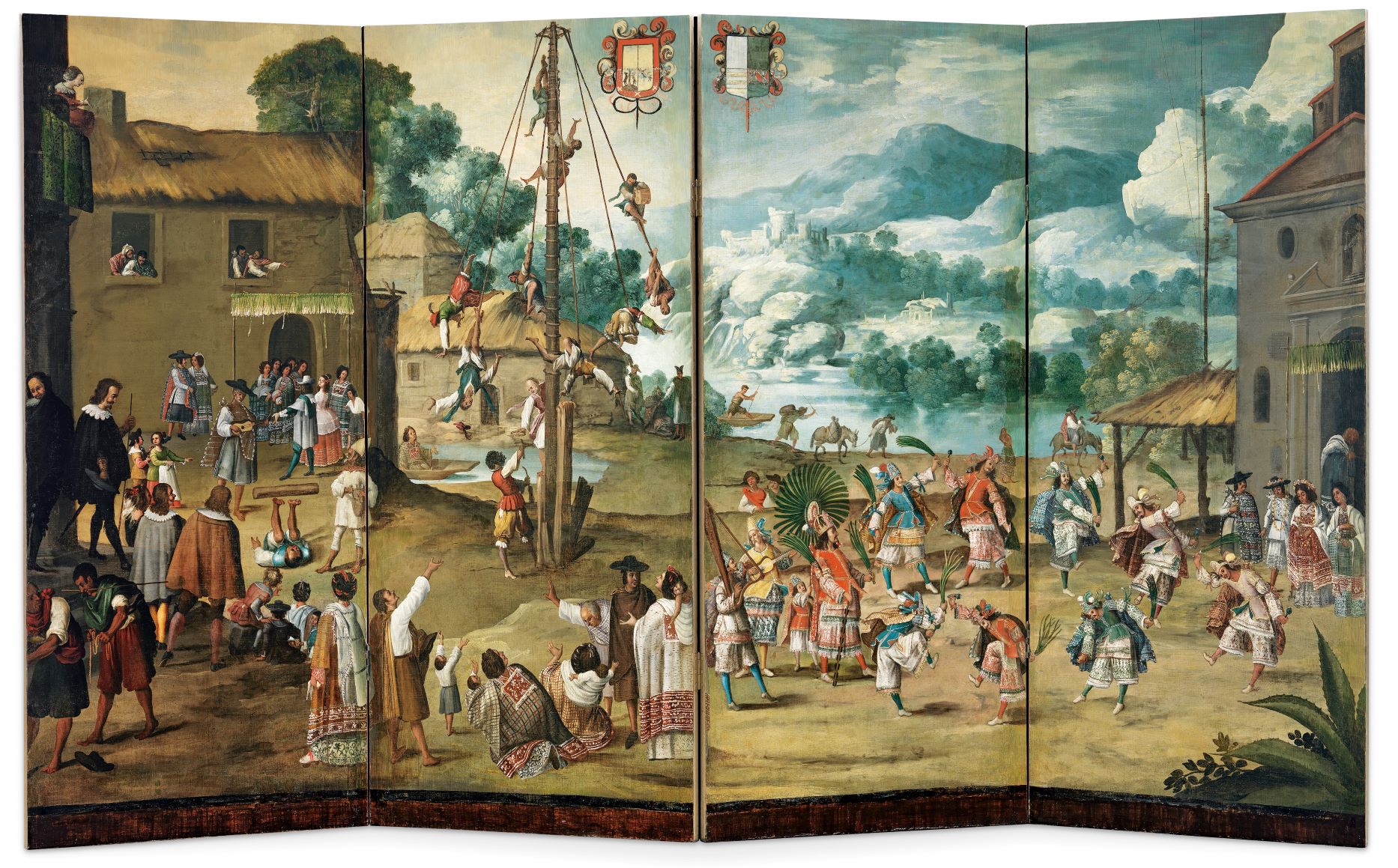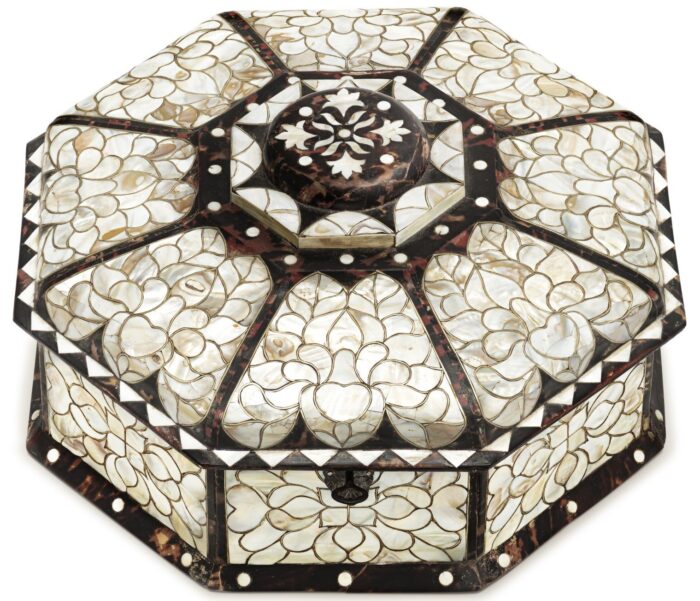Art and Imagination in Spanish America, 1500–1800:
Highlights from LACMA’s Collection
October 20, 2023–January 28, 2024

NASHVILLE, Tenn. (September 6, 2023)—The Frist Art Museum presents Art and Imagination in Spanish America, 1500–1800: Highlights from LACMA’s Collection, an exhibition of paintings, sculptures, decorative arts, and more created in Mexico and Central and South America during the early modern era. This is the first exhibition from the Los Angeles County Museum of Art (LACMA)’s notable holdings of Spanish American art and will be on view in the Frist’s Upper-Level Galleries from October 20, 2023, through January 28, 2024.
The exhibition, organized by Ilona Katzew, curator and department head of Latin American Art at LACMA, features more than 90 works from Guatemala, Mexico, Peru, Colombia, and Ecuador in a range of media, many of which are recent acquisitions. With an emphasis on the complex dynamics that led to the creation of these powerful artworks, Art and Imagination underscores the creative power of Spanish America and its central position as a global crossroads.
The early modern era (ca. 1500–1800) was a period marked by imperial expansion, conquest, colonization, and the transatlantic slave trade. Cataclysmic social and geopolitical shifts brought people into closer contact than ever before, sparking an evolution of the material culture around them.After the Spaniards began colonizing the Americas in the late 15th century, artists in the region drew from a wide range of traditions—Indigenous, European, Asian, and African—reflecting the interconnectedness of these cultures and ideas in the early modern world.



“Spanish America was neither a homogeneous nor a monolithic entity, and local artists were not passive absorbers of foreign traditions,” said Katzew. “Without ignoring the profound violence that marked the process of conquest and colonization, this exhibition and accompanying catalogue emphasize the intricate social, economic, and artistic dynamics that led to the creation of astounding artworks within the budding new societies.”
The Spanish conquest of part of the Philippines in 1565 inaugurated a commercial route that connected Asia, Europe, and the Americas. Private homes and civic and ecclesiastic institutions in Spanish America were filled with imported and locally made objects. In turn, many objects from Spanish America also traveled across the globe, attesting to their wide appeal. This confluence of riches signaled the status of the Americas—what one contemporaneous author described as “the archive of the world.”
Among the exhibition’s highlights are the recently acquired and restored Pietá by the Potosí (Bolivia) painter Melchor Pérez Holguín, an impressive folding screen depicting an Indigenous wedding scene near Mexico City painted by an unidentified 17th-century artist, and a series of eye-catching works employing mother-of-pearl known as enconchados.
Organized thematically, the exhibition begins with “Eyes of the Imagination: Envisioning the Divine,” a section containing large devotional images, many of which were commissioned for altarpieces and monastic cycles in the Catholic church. While the church played an important role in spreading European religious subjects, local artists retained significant agency, often grounding their compositions in local histories. “Fashioning Identity” includes costumes and paintings that demonstrate how dress could construct and reinforce social and ethnic differences, as seen in the 18th-century Mexican casta (caste) paintings; “Converging Materials” focuses on the widespread influx of luxury goods from Asia and elsewhere and their ingenious transformation by local artists, including lacquerware and shell-encrusted paintings and furnishings. “The Art of Two Artists: The Culture of Copies” looks at how the tradition of creating pictorial copies by referencing local and foreign source material was part of the creative process of artists, demonstrating the fluid circulation of images and ideas between Europe and Spanish America. The exhibition concludes with “Intimate Faiths,” a selection of small-scale paintings, sculptures, and finely rendered badges worn by nuns and friars for private and domestic devotional use.
Exhibition Publication
The exhibition is accompanied by a major catalogue that represents the first comprehensive study of LACMA’s notable holdings of Spanish American art. Written and edited by Ilona Katzew, the book is exquisitely illustrated with new photography and filled with fresh new scholarship and information about the formation of LACMA’s collection and nearly 100 catalogue entries by various scholars. Published by LACMA and DelMonico Books D.A.P.
Program
Thursday, October 19
Curator’s Perspective: The Art of Spanish American Through the Lens of LACMA’s Collection
6:30–7:30 p.m.
Auditorium
Free; first come, first seated
This curator’s perspective is presented by Ilona Katzew, curator and department head, Latin American Art, Los Angeles County Museum of Art. Established over the last fifteen years, the Los Angeles County Museum of Art’s collection of Spanish American art encompasses a splendid range of paintings, textiles, and decorative arts represented in Art and Imagination in Spanish America, 1500–1800. The central theme of the exhibition and much of the impetus behind the formation of the collection is the connection of cultures and ideas in the early modern world. In light of the rising interest in Spanish American art internationally, this talk will address the pivotal role that museums can play in shaping the field and promoting discussion.
Recognized as one of the leading curators and scholars in her field, Ilona Katzew formed LACMA’s collection of Spanish American art and has made highly visible acquisitions of modern and contemporary Latin American art, including design. She has curated numerous exhibitions and has lectured widely across the United States, Latin America, and Europe.
Exhibition Credit
Organized by the Los Angeles County Museum of Art
Supported in part by the Sandra Schatten Foundation
Program and Spanish Translation Sponsor: Center for Latin American, Caribbean, and Latinx Studies at Vanderbilt University
The Frist Art Museum is supported in part by The Frist Foundation, Metro Arts, the Tennessee Arts Commission, and the National Endowment for the Arts.
Image Credits
1. Unidentified artist (Mexico). Folding Screen with Indigenous Wedding, Mitote, and Flying Pole (Biombo con desposorio indígena, mitote y palo volador), ca. 1660–90. Oil on canvas; overall (4 panels): 66 × 120 in. Los Angeles County Museum of Art, purchased with funds provided by the Bernard and Edith Lewin Collection of Mexican Art Deaccession Fund. Photo © Museum Associates/LACMA
2. Guatemala (for export market, possibly Peru). Sewing or Jewelry Box (Costurero o joyero), last third of the 18th century. Los Angeles County Museum of Art, purchased with funds provided by the Bernard and Edith Lewin Collection of Mexican Art Deaccession Fund. Photo © Museum Associates/ LACMA
3. Antonio de Arellano (Mexico, 1638–1714); Manuel de Arellano (Mexico, 1662–1722). The Virgin of Guadalupe (Virgen de Guadalupe), ca. 1690. Oil on canvas; 20 7/8 × 9 13/16 × 9 7/16 in. Los Angeles County Museum of Art, purchased with funds provided by the Bernard and Edith Lewin Collection of Mexican Art Deaccession Fund. Photo © Museum Associates/LACMA
4. Unidentified sculptor and polychromer (Guatemala). Saint Michael Vanquishing the Devil (San Miguel triunfante sobre el demonio), second half of the 18th century. Polychromed and gilded wood, silver gilt, bone, and glass; 20 × 14 1/2 × 8 1/2 in. Los Angeles County Museum of Art, purchased with funds provided by the Bernard and Edith Lewin Collection of Mexican Art Deaccession Fund. Photo © Museum Associates/ LACMA.
Connect with us @FristArtMuseum #TheFrist
FOR ADDITIONAL INFORMATION
Buddy Kite: 615.744.3351, bkite@FristArtMuseum.org
Ellen Jones Pryor: 615.243.1311, epryor@FristArtMuseum.org
